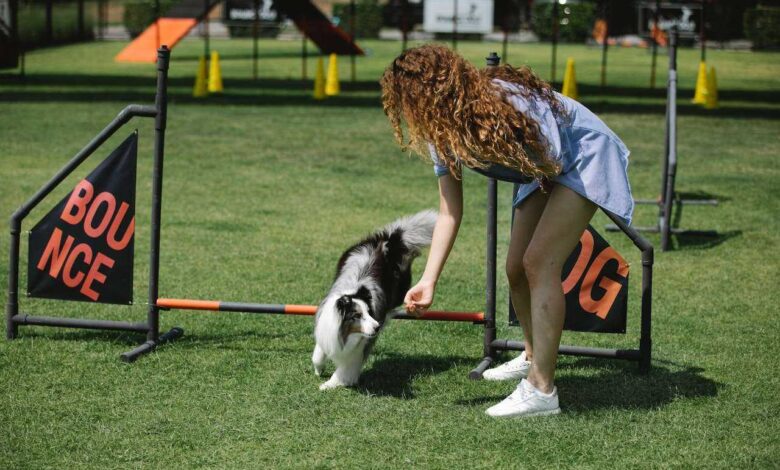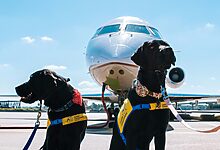Advanced Dog Training: Beyond Basic Commands

Congratulations on reaching the point where you’re ready to take your dog’s training to the next level! Beyond basic commands lies a world of advanced dog training that includes teaching impressive tricks, agility, advanced obedience, and preparing your pup for specialized roles such as working, service, therapy, or detection dogs. In this comprehensive guide, we’ll delve into various aspects of advanced dog training to help you and your furry friend unlock their full potential.
Table of contents
Dog Tricks
How to Train Your Dog Tricks
Teaching your dog tricks is not only enjoyable but also strengthens the bond between you and your pet. Here’s a step-by-step guide to get started:
- Start with Basics: Ensure your dog has mastered fundamental commands like sit, stay, come, and down. These commands form the foundation for more complex tricks.
- Choose Tricks Wisely: Select tricks that align with your dog’s personality, physical capabilities, and interests. Some dogs excel at fetching, while others shine at agility tricks.
- Divide and Conquer: Break down each trick into smaller, manageable steps. For example, teaching your dog to roll over involves phases like lying down, turning the head, and completing a full roll.
- Positive Reinforcement: Use treats, praise, and affection as rewards when your dog makes progress or successfully performs a trick. Positive reinforcement is a powerful motivator.
- Patience is Key: Dogs learn at their own pace, so maintain patience throughout the training process. Never resort to punishment or scolding; it can hinder progress.
- Regular Practice: Consistency is crucial. Short, frequent training sessions are more effective than infrequent, lengthy ones.
- Stay Positive: Maintain a positive attitude during training sessions. Keep them enjoyable for your dog, and you’ll both look forward to learning new tricks.
Dog Agility
How to Train Your Dog for Agility
Agility training is an exhilarating sport that involves navigating your dog through a timed obstacle course. Here’s how to get started:
- Establish Basic Obedience: Ensure your dog responds reliably to commands like sit, stay, and come. These commands lay the groundwork for agility training.
- Introduce Agility Equipment: Familiarize your dog with various agility equipment, including tunnels, jumps, weave poles, A-frames, and seesaws. Start with low-intensity obstacles to build confidence.
- Lure and Reward: Use treats or toys to motivate your dog through the agility course. Initially, focus on simple obstacles to prevent overwhelming your pup.
- Gradual Complexity: As your dog becomes more skilled, gradually increase the complexity of the course. Challenge them with higher jumps and weaving through poles at varying speeds.
- Build Confidence: Allow your dog to explore and interact with the equipment without pressure. Positive experiences foster confidence and enthusiasm.
- Handler Training: Handlers also play a crucial role in agility. Training handlers on how to effectively guide their dogs through the course is essential for success.
- Compete or Have Fun: Decide whether you want to compete in agility trials or simply enjoy agility as a recreational activity with your dog. Either way, it’s a fantastic way to keep both of you active and engaged.
Dog Obedience
How to Train Your Dog for Obedience
Advanced obedience training takes your dog’s responsiveness and behavior to the next level. Here’s how to achieve advanced obedience:
- Master Basic Commands: Ensure your dog obeys basic commands like sit, stay, come, down, and heel flawlessly before moving on to advanced obedience.
- Introduce Distractions: Practice obedience commands in various environments with increasing distractions. This helps your dog remain focused even in challenging situations.
- Positive Reinforcement: Continue to use positive reinforcement in the form of treats, praise, or toys to reward desired behaviors.
- Extend Duration and Distance: Gradually increase the duration your dog holds commands and the distance at which they respond. This strengthens their obedience skills.
- Off-Leash Training: Transition to off-leash training in safe, enclosed areas as your dog progresses. A long leash can be used as a safety measure during this phase.
- Advanced Commands: Teach advanced commands such as stand, wait, and leave it to enhance your dog’s obedience and versatility.
- Real-Life Situations: Practice obedience commands in real-life scenarios, such as encountering other dogs or people during walks. This helps your dog become well-behaved in any situation.
Dog Roles and Specializations
How to Train Your Dog for Special Roles
If you’re interested in preparing your dog for specialized roles, such as working, service, therapy, or detection, here’s what you need to know:
- Identify Aptitude: Assess your dog’s temperament, energy level, and specific skills to determine their suitability for a particular role. Different roles require varying traits.
- Professional Training: Enroll your dog in specialized training programs conducted by professionals who have expertise in the specific field you’re interested in.
- Working Dogs: These roles include police dogs, military dogs, and search and rescue dogs. Training for these roles is intensive and involves specific skills tailored to the job.
- Service Dogs: Service dog training focuses on assisting individuals with disabilities, such as guide dogs for the blind, mobility assistance dogs, and medical alert dogs.
- Therapy Dogs: Therapy dogs provide comfort and emotional support in therapeutic settings like hospitals or nursing homes. Temperament and social skills are vital for these roles.
- Detection Dogs: Dogs in detection roles are trained to identify specific scents, such as narcotics or explosives. This requires rigorous scent training.
- Certification: Depending on the role, certification may be necessary to ensure your dog meets the required standards. Certifications are often obtained through organizations dedicated to each specific role.
By advancing your dog’s training, you’ll not only unlock their full potential but also create a deeper and more meaningful bond. Whether it’s performing impressive tricks, mastering agility, achieving impeccable obedience, or taking on specialized roles, advanced training enriches your dog’s life and showcases their incredible capabilities. Remember that patience, consistency, and positive reinforcement are key to success in advanced dog training. Enjoy the journey as you and your four-legged friend explore new horizons together!





